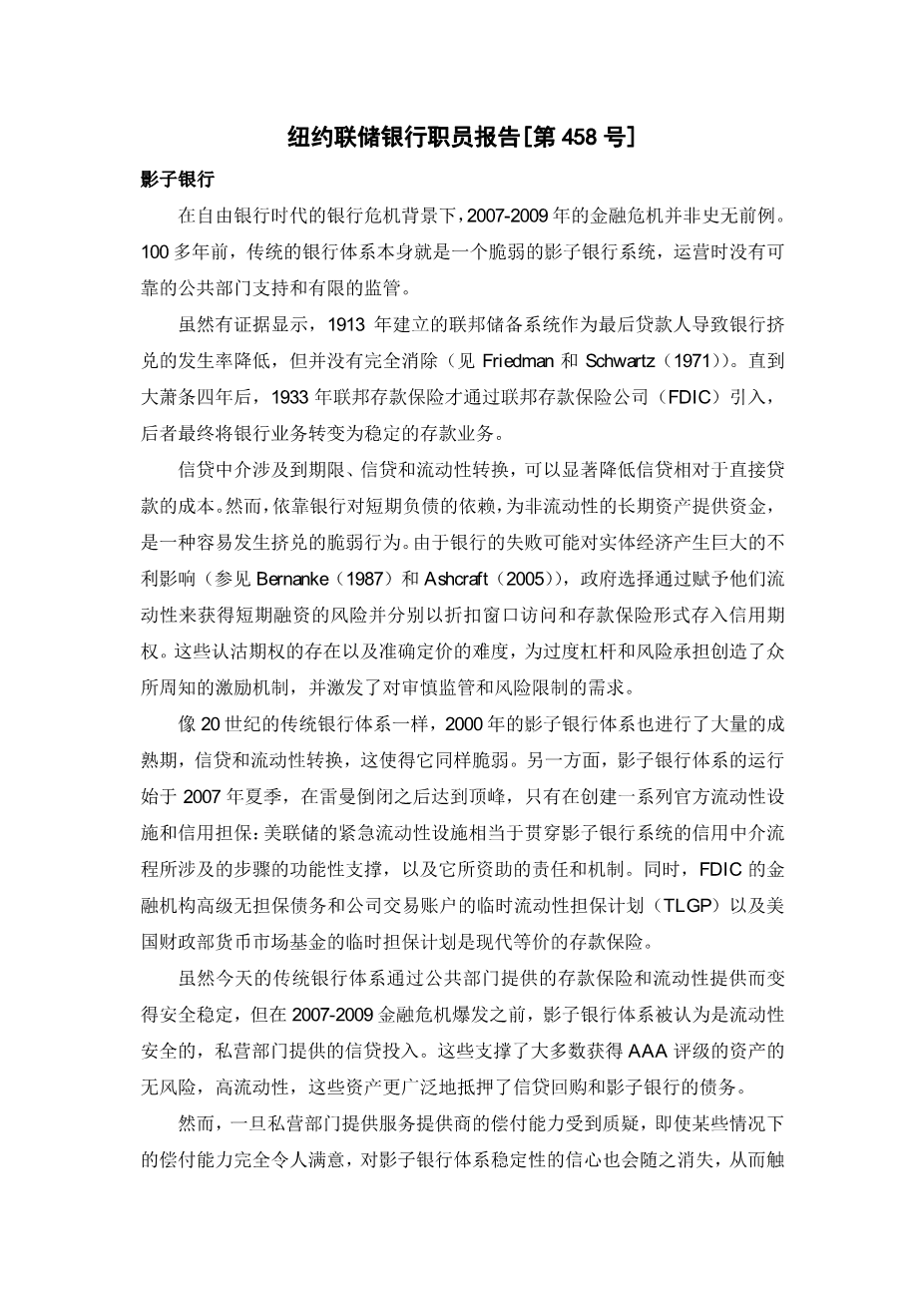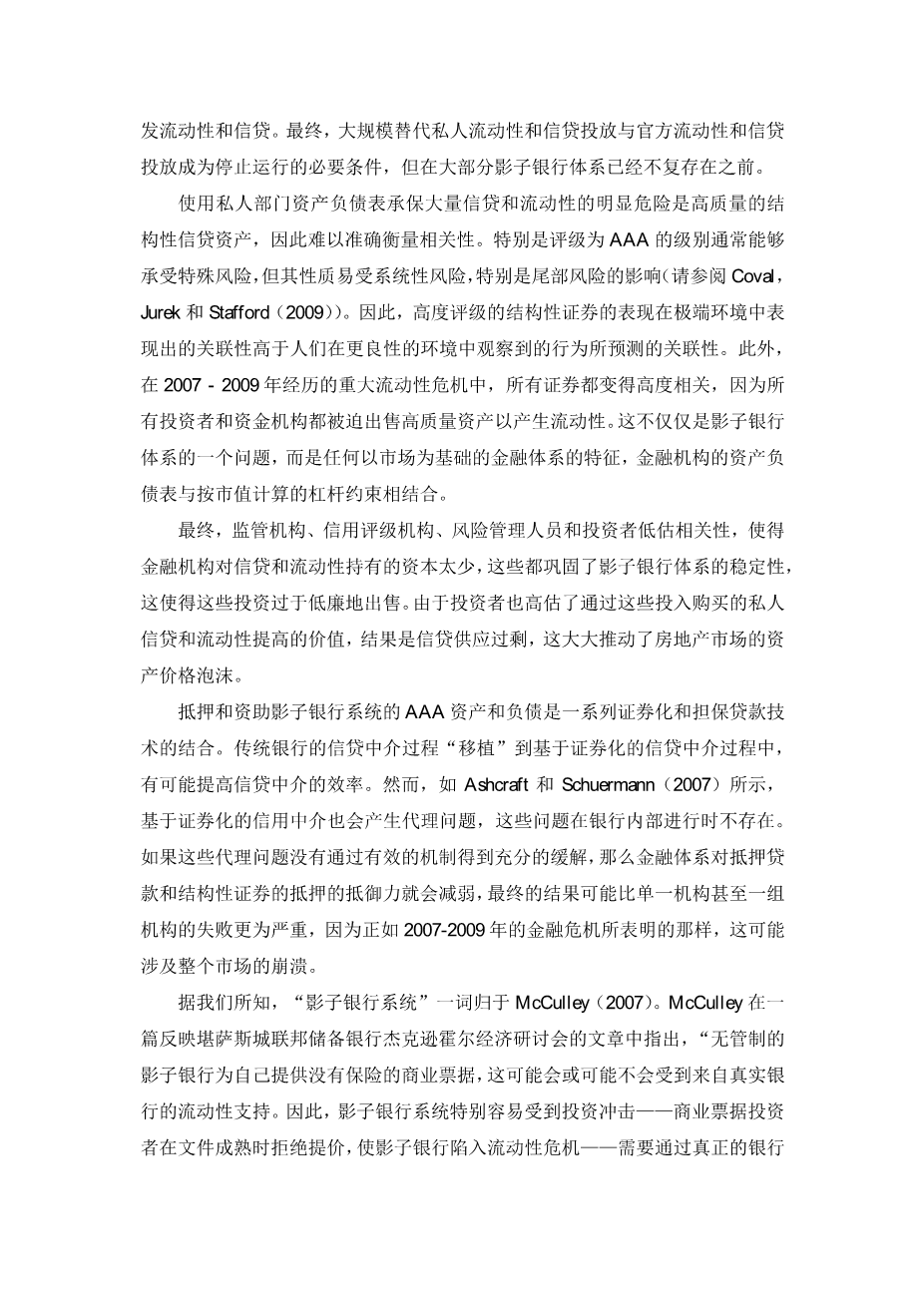Federal Reserve Bank of New York Staff Reports [No.458]
SHADOW BANKING
The financial crisis of 2007-2009 is not unprecedented in the context of the banking crises of the free banking era. Over 100 years ago, the traditional banking system was an inherently fragile, shadow banking system operating without credible public-sector backstops and limited regulation.
While there is some evidence that the creation of the Federal Reserve System as lender of last resort in 1913 lead to a reduction in the occurrence of bank runs, it did not completely eliminate them (see Friedman and Schwartz (1971)). It was only after four years of Depression that in 1933 federal deposit insurance was introduced through the Federal Deposit Insurance Corporation (FDIC), which ultimately transformed banking into a stable activity insulated from deposit runs.
Credit intermediation involves maturity, credit, and liquidity transformation which can significantly reduce the cost of credit relative to direct lending. However, the reliance on short-term liabilities by banks to fund illiquid long-term assets is an inherently fragile activity that is prone to runs. As the failure of banks can have large, adverse effects on the real economy (see Bernanke (1987) and Ashcraft (2005)), governments chose to shield them from the risks inherent in reliance on short-term funding by granting them access to liquidity and credit put options in the form of discount window access and deposit insurance, respectively. The presence of these put options, combined with the difficulty of accurately pricing them, creates well-known incentives for excessive leverage and risk-taking, and motivates the need for prudential regulation and risk limits.
Like the traditional banking system of the 1900s, the shadow banking system of the 2000s engaged in significant amounts of maturity, credit, and liquidity transformation, which made it just as fragile. In a further parallel, the run on the shadow banking system, which began in the summer of 2007 and peaked following the failure of Lehman, was only stabilized after the creation of a series of official liquidity facilities and credit guarantees: the Federal Reserve’s emergency liquidity facilities amounted to functional backstops of the steps involved in the credit intermediation process that runs through the shadow banking system, and the liabilities and mechanisms through which it is funded. Meanwhile, the FDIC’s Temporary Liquidity Guarantee Program (TLGP) of financial institutions’ senior unsecured debt and corporate transaction accounts, and the U.S. Treasury’s temporary guarantee program of money market funds, are modern-day equivalents of deposit insurance.
While today’s traditional banking system was made safe and stable through the deposit insurance and liquidity provision provided by the public sector, the shadow banking system—prior to the onset of the financial crisis of 2007-2009—was presumed to be safe due to liquidity and credit puts provided by the private sector. These puts underpinned the perceived risk-free, highly liquid nature of most AAA-rated assets that collateralized credit repos and shadow banks’ liabilities more broadly.
However, once private sector put providers’ solvency was questioned, even if solvency in some cases was perfectly satisfactory, confidence in the liquidity and credit puts that underpinned the stability of the shadow banking system vanished, triggering a run. Ultimately, a wholesale substitution of private liquidity and credit puts with official liquidity and credit puts became necessary to stop the run, but not before large portions of the shadow banking system were already gone.
The obvious danger in using private sector balance sheets to underwrite large quantities of credit and liquidity puts against high-quality structured credit assets is the difficulty in accurately measuring correlation. In particular, AAA-rated tranches are generally structured to withstand idiosyncratic risk, but by their nature are vulnerable to systematic risk and particularly tail risk (see Coval, Jurek and Stafford (2009)). Consequently, the performance of highly-rated structured securities exhibits higher correlation in an extreme environment than one would predict from observed behavior in a more benign environment. Moreover, in a major liquidity crisis of the type experienced in 2007-2009, all securities become highly correlated as all investors and funded institutions are forced to sell high quality assets in order to generate liquidity. This is not simply an issue for the shadow banking system, but is a feature of any market-based financial system where financial institutions’ balance sheets are tied together with mark-to-market leverage constraints.
Ultimately, the underestimation of correlation by regulators, credit rating agencies, risk managers, and investors permitted financial institutions to hold too little capital against the credit and liquidity puts that underpinned the stability of the shadow banking system, which made these puts unduly cheap to sell. As investors also overestimated the value of private credit and liquidity enhancement purchased through these puts, the result was an excess supply of credit, which contributed significantly to asset price bubbles in real estate markets.
The AAA assets and liabilities that collateralized and funded the shadow banking system were a combination of the product of a range of securitization and secured lending techniques. Traditional banks’ credit intermediation process “transplanted” into a securitization-based credit intermediation process has the potential to increase the efficiency of credit intermediation. However, securitization-based credit intermediation also creates agency problems which do not exist when these activities are conducted within a bank, as illustrated by Ashcraft and Schuermann (2007). If these agency
剩余内容已隐藏,支付完成后下载完整资料


英语译文共 4 页,剩余内容已隐藏,支付完成后下载完整资料
资料编号:[464043],资料为PDF文档或Word文档,PDF文档可免费转换为Word


